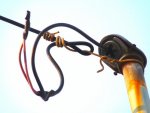HomeInspectorKenton
Member
- Location
- Boulder, Colorado
I am writing home inspection courses for pre-purchase home inspectors in Mexico, and this is not a home I inspected but a condition I photographed from the street, I have no access to the service panel. I've never seen only one conductor entering a masthead before. I assume it's a hot leg (127 volts here). Without a grounded conductor with which to complete a circuit and return current to the pole, I didn't even know a home electrical system would work. Apparently it does. Is it possible that the home is a two-wire system and that the neutral terminates at a grounding electrode?
How dangerous is this? What exactly is the danger? I don't even know what to tell pre-purchase home inspectors to say in their reports, other than have it corrected by a qualified electrical contractor. Should the system be shut down immediately?
How dangerous is this? What exactly is the danger? I don't even know what to tell pre-purchase home inspectors to say in their reports, other than have it corrected by a qualified electrical contractor. Should the system be shut down immediately?

